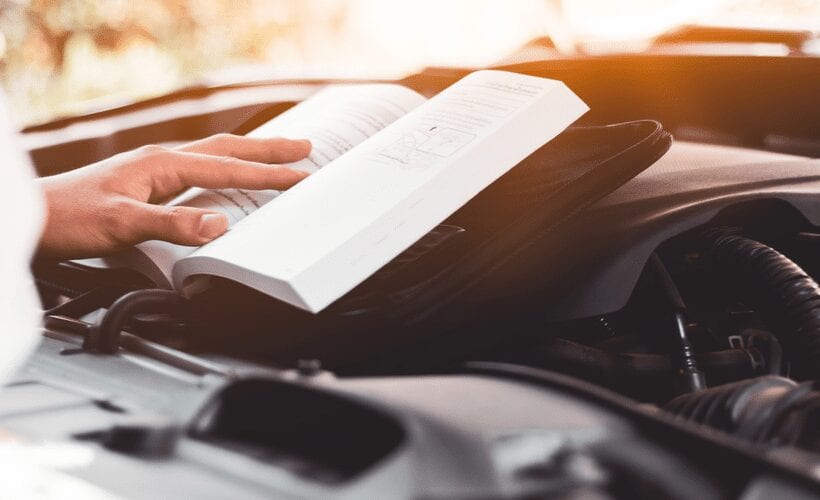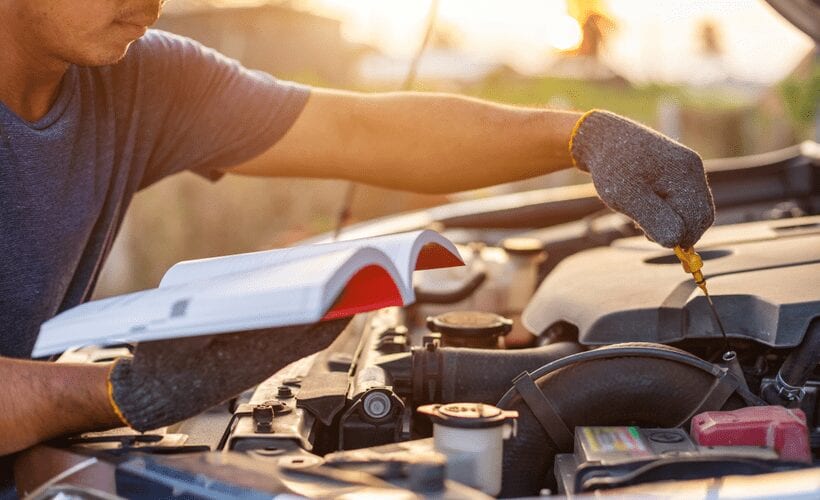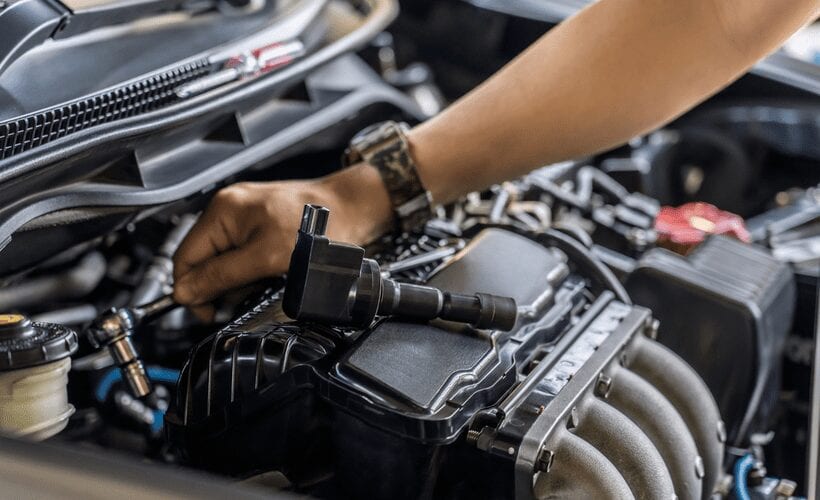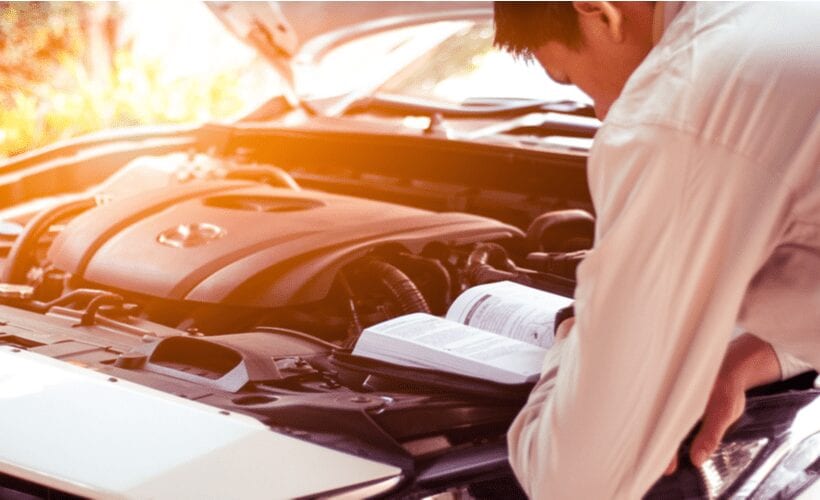Deciphering Your Car’s Owner Manual
Deciphering Your Car’s Owner Manual
We are privately owned and not affiliated with the government in any way or form.

Introduction
Today, most people are quick to assess problems with their vehicle by going online. And while the internet can be a convenient source of information at times, your car’s owner’s manual is your best bet when dealing with your specific vehicle, especially since most vehicles’ attributes can vary according to trim, package or region where the automobile was manufactured.

Significant changes to the interior accessories, hardware and motor can occur from one year to the next, while a vast majority of the car’s other characteristics can stay the same. The internet will rarely provide such specific results on your unique vehicle. Your owner’s manual, however, will serve as a reliable reference for properly setting up a new vehicle, troubleshooting problems and understanding system warnings or procuring the right replacement parts.
Getting Familiar With Your Car’s Owner’s Manual
Referring to the owner’s manual when you suspect there is trouble may prevent you from executing the wrong procedures or paying a mechanic to take incorrect action.
Familiarizing yourself with your owner’s manual before coming across any problems will benefit you greatly, as it outlines the type of fluids needed, the technology and switches featured in your vehicle model, and the overall maintenance schedule approved for your model. Some manuals even detail how the car should be expected to perform and be driven, especially over the first few thousand miles.
A manual can give an owner insight regarding specialty features of the vehicle, like entertainment systems and climate control, 4×4 activation, maintenance best-practices or handling roadside emergencies.
Get accustomed to the contents of your owner’s manual so you can minimize cost and time spent assessing the trouble by quickly referring to the best diagram or instructions when dealing with error codes, burnt fuses or low oil levels. Keep the manual stored in your vehicle, close at hand for emergency situations. You’d kick yourself if you needed it on the side of the highway as you remember you left it in the garage at home.
Common storage areas within the vehicle include the glove box, compartments under the seats, in a storage console (arm rest) between the front driver and passenger seats, the trunk or pockets attached to seats or door panels. Keeping it in a designated location will help to avoid losing it and having to buy another manual down the line.
In addition to being a valuable compilation of info, the owner’s manual also obtains the best ways to clean the vehicle, manufacturer contact information, warranty details and parts information. Read up on you owner’s manual to leverage the advice therein, make informed decisions, set up maintenance reminders ahead of time and prolong the life of your investment.
Bookmark These Sections in Your Manual
With all of the knowledge stored within the pages of your owner’s manual, it can be a little intimidating knowing where to start when you really need it.

Reviewing the manual when you first acquire your vehicle and bookmarking essential pages will help you to quickly and efficiently get through your emergency protocol or maintenance project when the time comes. Other times, having a page bookmarked can provide convenience, such as easily resetting the clock or pairing your new phone to the car’s Bluetooth.
Reference the information you need with the assurance that the answer you find is the right one for your vehicle. Bookmark the following pages for reference, emergencies and maintenance, all the while saving yourself from wasting time or stressing out.
Introduction and Instrument Cluster
While these are separate sections of the manual, both discuss similar topics. The Introduction acquaints you with symbols and icons you will see in the instrument cluster (sometimes referred to as the instrument panel or even dashboard display). The Instrument Cluster section will expound on topics from the Introduction. Familiarizing yourself with the symbols used in both sections will help you understand how to best take action when one of the in-dash icons light up (i.e., check engine, tire pressure low, etc.).
Some things will be easily identifiable, like the fuel gauge, while brushing up on other parts like the engine temperature gauge or tachometer will increase your knowledge of how your vehicle works and if you are operating within its intended boundaries.
Entertainment
The Entertainment section explains how to establish radio presets, connect to Bluetooth or navigation in newer cars, and how to use any number of entertainment options in the vehicle. You can manipulate how the speakers produce sound, how to interact with different media such as USB, Satellite radio, auxiliary cords or hands-free talking through your phone.
Control display settings, language preferences or even video display (navigation, back-up camera and DVD/Blu-ray) options from the Entertainment settings to customize your driving experience. Older vehicle manuals will explain the proper uses of cassette tape players or CD changers.
Driver Controls
Anyone who has ever owned a car and purchased or leased a new one will realize that the controls from the old vehicle do not directly translate to the new vehicle’s controls. The Driver Controls section will outline the location and functions of the many buttons, levers and switches contained on or around the steering wheel and main console. Here you can learn how to adjust the steering wheel height, adjust mirrors and use the windshield wipers and washer fluid. It will also identify any storage compartments, seat adjustments, windows and locks, air conditioning and heating and other programmable features of the vehicle. Owners will also be able to understand engaging and disengaging overdrive, 4-wheel drive and identifying fuel door, hood and trunk releases.
Driving
The Driving category of the owner’s manual covers a range of topics, from starting the car, to manual or automatic transmission, the brake system, cruise control, suspension information and special driving operation. The beginning of any driving portion of an owner’s manual will usually contain a list of warnings or driving hazards of which you must take special note; not heeding these warnings can result in irreparable damage to the car or even death in extreme cases. Some of these warnings include:
- Distracted driving risks
- Fire hazards
- Seatbelt requirements
- Being under the influence of alcohol or drugs while driving
Under Driving in the owner’s manual, learn how to start the ignition with or without a key, ignition positions (turning on electrical power without engaging the engine), how to set up cruise control, using the emergency brake and the gear layout (for manual transmission vehicles). For automatic transmissions with sport options or semiautomatic vehicles with paddle shifters, there will be instructions on how to properly use these features while driving, as well as the use of economic driving options and controls.
With changing seasons and erratic weather patterns, it is inevitable that you will drive in suboptimum conditions which may include rain, hail, flooding, snow or iced-over roads. The special Driving Operation subsection will detail techniques to deal with extreme weather conditions, night and highway driving and towing.
Roadside Emergencies
Some auto manufacturers offer free roadside assistance and list the contact information in the Roadside Emergencies section of the owner’s manual. Check yours to see if there is a free or paid program available for you. Otherwise, this section needs to be bookmarked to reference how and when to operate hazard lights, how to reset a fuel pump shut-off switch, where to locate the spare tire and jack, how to change a spare tire, spare tire driving specifications, jump starting a battery and towing procedures.
Maintenance and Specifications

One of the most underutilized sections in any owner’s manual, the Maintenance portion of the manual details everything you need to know to keep your car in good, working order. Here you can find information regarding:
- Identifying engine components and engine data
- Fluid types and capacities
- Battery requirements
- Lubricant specifications
- Part numbers
- Maintenance schedules and procedures
Depending on your owner’s manual, other helpful tidbits include how to check your oil level, or how and where to dispose of old fluids. Newer model vehicles may even come with a separate maintenance log to assist in keeping track of and scheduling all the recommended tasks over the life of the automobile.
Index
Perhaps the most valuable part of the owner’s manual, the index enables an owner who is not familiar with the overall structure of the manual’s material to quickly refer to the section he or she needs. The Index is always placed at the very end of the owner’s manual, listing out part names and sections alphabetically.
For example, if you’re looking for information on your car’s battery, simply go to the “B” section of the index, look for the keyword Battery and jump to the listed page number. With the Table of Contents giving you a more general view of the material order, the Index forgoes book order to provide exact page location.
How Your Owner’s Manual Can Help You Stay Safe
Planning and preparing for emergencies can greatly reduce injury and unsafe outcomes in the future. Likewise, your car’s owner’s manual highlights a variety of simple and practical features that can be life-saving.

From the proper use of restraints to precautions about driving, the owner’s manual covers the many ways your vehicle can help keep you alive and well. Get to know the safety features of your vehicle through the owner’s manual and drive with confidence.
Precaution Symbols
Throughout every owner’s manual, you will notice precaution symbols detailing a common danger associated with the section you are reading. These warnings cover a range of measures to ensure the safety of the vehicle’s occupants or the safety of the vehicle systems. From avoiding the use of seat covers to allow proper side airbag deployment, to the best practices of jump starting a battery, these safety measures can prolong the life of your vehicle and its components and help you to avoid injury.
Seats and Safety Belts
Your seats do more than give you a place to sit while operating your vehicle; all come equipped with head restraints and seatbelts. Proper use of seatbelts at all times while driving is compulsory. Driving, or even riding as a backseat passenger without the use of a seatbelt may result in a traffic ticket; more importantly, the restraints can drastically reduce any damage incurred from a collision.
The manual points out all the seat and safety belt adjustments which can be made to make the seat adhere to your body in the safest manner. Modern vehicles feature an audible safety belt reminder when a passenger is occupying a seat but not wearing a safety restraint while the engine is on. The sound will typically continue until the seatbelt is properly fastened.
Your owner’s manual also covers the proper way to install baby/booster seats and how to incorporate the vehicle’s seatbelts and tether anchors while doing so. Follow the manufacturer’s protocol to correctly install seats for children.
Airbags
Depending on your vehicle’s year, model and safety ratings, you may have one, two or several airbags surrounding you at any given time. Read the manual to understand when each will deploy upon impact, and the sensors that determine deployment. Some vehicles give the option of turning off passenger airbags. Understand your vehicle’s policy on airbags and rear-facing child seats, as they pose the greatest threat to children occupying them during an accident.
Brakes
Vehicles offer a range of brake technologies based on the year of manufacture. Some will come with Power Brakes, Anti-lock Braking Systems (ABS) or some variation thereof. All vehicles are equipped with emergency brakes. The Brakes section of your manual will discuss your vehicle’s particular style of brakes and how to safely maintain or employ them in emergency situations. In the event of brake failure, the manual may suggest using the emergency brake, and explains how stopping distances and times may increase.
Driving
The Driving section of your manual contains the complete list of safety features equipped in your vehicle. Owners of older model cars or trucks may only possess a few of the following safe-driving features:
- Electronic Stability Control (ESC)
- Vehicle Stability Management (VSM)
- Back-up cameras and/or sensors
- Park assist (Self-parking)
- Voice controls
- Adaptive cruise control
- Adaptive headlights
- Blind-spot warning
- Lane-departure warning
- Forward collision warning + auto braking
Each of the above can help to avoid catastrophic accidents or injuries. Some manuals even discuss the dangers of distracted driving (i.e., texting while driving). Additional subjects your manual will outline cover the safest approaches to nighttime driving, driving off-road, in rain or floods or in icy conditions. Driving also details safe seating limits as well as cargo weight capacities. Check your Driving section to fully understand the depth of safety options afforded to you while your vehicle is in motion.
Emergency
The Emergency section of your owner’s manual provides best practices for dealing with roadside emergencies. Emergency discusses the use of hazard lights to alert passersby of your status, when it is safe to check fluids under the hood, how to connect jumper cables to your battery the right way and how to change a flat. The Tire Pressure Monitoring Systems (TPMS) may be available to you as well, and can indicate when it is time to add air to your tires, contributing to fewer unexpected roadside tire changes in the future.
Other important safety tips may entail identifying stripped lug nuts or towing procedures. Review your manual to retain a good understanding of your vehicle’s safety features to ensure the safety of yourself and your passengers.
Starting and Driving Your Vehicle: Tips From Your Owner’s Manual
Most people have a general idea that maintenance and reference information is readily available within the pages of their car’s owner’s manual.

However, most people are not aware of the particulars listed for starting the vehicle and driving; you know, the thing your automobile was made to do!
The Driving section of your owner’s manual provides information regarding starting the engine, driving and shifting, braking, understanding the instrument cluster and all the intricacies associated with piloting your vessel.
Before Driving
So many flat tires and minor accidents can be avoided simply by conducting a brief inspection outside and within the vehicle before departure. The Driving section will point out what to check for in your general surroundings, around your tires and underside of the car, as well as things to be mindful of before setting out on the road. Vehicles with Remote Vehicle Start and Remote Keyless Entry (RKE) will describe the procedures, limitations and benefits of not having to use a key to enter and exit the vehicle, such as lockout protection.
Starting the Vehicle
Today, many consumers are making the transition from key-start ignitions to push-to-start systems. Either way, there are a few things you should understand about either system included with your vehicle. For example, manuals for key-start ignitions will outline the ignition positions associated with locking the steering wheel, engaging the electrical components only and fully starting the engine.
Likewise, manuals for push-to-start enabled automobiles will detail the process of starting the engine, stopping the engine as well as warnings against pushing the ignition button while driving. Driving will also impart the dangers of turning off the engine while still in gear. Other pieces of pertinent information include starting the vehicle in neutral or park, and the role of the parking brake while starting, stopping or parking on inclines and declines.
Shifting While Driving

In its Driving section, your manual outlines how to use your Shifter knob/lever, sequential shift modes and paddle positions, depending on the features that came with your vehicle. This portion will diagram the shifter layout (which is especially helpful for manual transmission vehicles) and proper use of the clutch, if applicable. Owners of manual transmission automobiles must take care while shifting to avoid causing damage to the transmission and clutch over time. Thoroughly review the shifting section to understand the subtleties of your shifters and gear operation when driving in special situations.
Operating the Vehicle
Knowing how to operate your vehicle under a range of conditions is pertinent in remaining safe. Driving covers distracted driving, defensive driving, driving in the rain or snow, traversing hills and mountains, off-road driving, running the vehicle while parked and modes of driving, i.e., tow/haul mode or four-wheel drive operation. Here, you can also learn about traction control, antilock brakes (ABS) and how to properly “break in” a new vehicle (not to be confused with breaking into). Some manuals offer tips for what to do in the event you are losing control (i.e., skidding), taking on curves or maneuvering around obstacles.
Driver Controls
The Driving section provides a comprehensive overview of your vehicle’s controls. Learn how to:
- Adjust mirrors to best see other cars in the vicinity
- Set cruise control speeds
- Use turn indicators
- Adjust seats and climate controls
- Open or close windows
- Employ child-safety locks
- Handle hands-free operations
- Use interior and exterior lights
Other controls may include overdrive options, engaging fuel economy modes or Electronic stability control (ESC). Vehicles with more technological upgrades may also offer magnetic ride control, locking rear axles or automatic level control.
Driver Assistance Features
An automobile’s safety features are highly dependent on the year your vehicle was manufactured. Driver Assistance Features have become more advanced over the last decade or so, and contribute to safe driving in an impactful way. Common driver assistance features include Forward Collision Alert (FCA), Front Automatic Braking (FAB) and Lane Departure Warning (LDW).
Understanding the Instrument Panel
Getting up and running is only a fraction of the driving experience. Most manuals will clearly explain the instrument panel and how to interpret the gauges and messages your vehicle is relaying to you. Here, Driving informs you how to read the tachometer (especially useful for manual transmission shifting), check the engine temperature, the fuel gauge and any warning lights from individual systems (tires, suspension, engine, etc.).
The most familiar gauge you’ll notice will be your speedometer, alongside your trip odometer. The instrument panel serves as the vehicle’s central hub of information and feedback. Brushing up on all of the indicators associated with this section of your owner’s manual can educate and prepare you for safety measures or maintenance needed over the years of ownership.
Using Your Owner’s Manual in Order to Prolong the Life of Your Vehicle
Your owner’s manual is teeming with helpful tips, schedules, diagrams and precautions that can prolong the life and condition of your automobile.
Its sole purpose is to inform you of how to best maintain the vehicle and keep it in good, working order. Ironically, the most ignored (and simultaneously most important) part of the manual is the Maintenance section. While mechanics have a good idea of what your vehicle needs and when, their estimations may suspiciously occur too frequently; contrary to their claims, most vehicles don’t require an oil change nearly as often as Lube shops advise.
Conversely, other critical maintenance needs may go unchecked until a system or part encounters irreversible damage. Refer to your owner’s manual to see how best to prolong the life and performance of your vehicle, and read on for manual section details.

Maintenance Section
Your car owner’s manual Maintenance section lists the fluids, oils, coolants, filters, bulbs, batteries and other parts that you need to repair, replace or change as part of regular upkeep. Adhering to the maintenance schedule (typically included as a separate booklet for newer vehicles) will keep your car running at optimum levels for many years to come.
While changing the oil is important, other upkeep is neglected. Your vehicle’s maintenance schedule clearly illustrates the necessary inspections based on mileage or time intervals alongside oil change requirements. Simply following the schedule as it is laid out can seamlessly keep your vehicle operating at a high level.
Cleaning Section
The Cleaning part of the owner’s manual may fall under Maintenance in some books. In any case, this section helps owners understand which chemicals, cleaning agents and waxes are suitable for the exterior paint and treated top coat of your vehicle, as well as interior materials. Using abrasive chemicals or waxes on the car may cause the paint to fade or may ultimately lead to rust. Severe rusting can greatly endanger the lives of a vehicle’s occupants.
Furthermore, using the wrong protectants on wood grain interior parts, the dashboard or seats can cause each of these components to dry up and crack over time, rendering them faded, broken and unusable. The Cleaning section is not solely meant for cosmetic purposes—this section also describes how to safely clean and maintain the engine and other components under the hood. Keeping the engine compartment clean can keep foreign objects from getting into fluid reservoirs, which could potentially cause engine damage and contribute to a variety of performance troubles.
Driving Section
The Driving portion of the owner’s manual may speak to the vehicle’s performance prowess in terms of engine size, torque, horsepower or acceleration. You can count on seeing how much you are able to push the vehicle, and how to expect it to perform under normal and extreme driving conditions. For example, your manual may advise against towing anything more than a couple of bicycles, or driving fast or aggressively, especially if the car has a four-cylinder engine or is not built for fast operation.
The Driving section will explain the type of driving (speed/performance, hauling/towing, fuel economy) best suited for the vehicle build. Operating the machine outside of its proposed functionality can degrade and damage its components far sooner than intended.
What To Do In An Emergency Section
The Emergency portion of the manual contains step-by-step instructions for dealing with some of the most commonly occurring roadside emergencies. Here, a person who has never changed a tire or jump-started a battery can learn the correct and safe way to conduct the operation. Following the instructions posed in the Emergency section can reduce injury or accidents directly related to breaking proper protocol.
You can also find the location of your car’s spare tire, tire iron and jack, if you have no prior knowledge of these parts. Understanding the Emergency tips can keep you safe while limiting any further damage to the vehicle. Refer to the Using Your Owner’s Manual in Cases of Emergency section of this guide for detailed information.
Precautions
Precautions are posted throughout the owner’s manual. These serve as special call outs when dealing with any number of operations, systems, hardware or chemicals related to your car. Some of these precautions include:
- Do not check fluids when the engine is hot.
- Do not have your car towed with sling-type equipment.
- Do not go beyond 20 mph when using tire chains.
- Do not work under the hood while the engine is running.
- Do not overload your vehicle beyond listed cargo weight limits.
- Do not use compact spare tires for prolonged periods of time.
This is a small sample of the precautions that may be listed in a manual and which can contribute to the longevity of your working vehicle. Be sure to follow all safety, maintenance, cleaning advice and precautions listed in your owner’s manual to prolong your ability to use your car over an extended period of time.

Common Questions That Your Owner’s Manual Can Answer
Q: Do I really need to get my oil changed every 3,000 miles? What other services do I need to have performed to maintain my car, and how often?
A: While 3,000 miles is a generally accepted interval for oil changes, the maintenance schedule in your owner’s manual will list the optimum mileage intervals and frequencies to perform this service. Some late-model vehicle manuals break down the oil change service requirements (and all other maintenance requirements) in terms of the life of the vehicle, per miles or months; for example, “at 67,500 miles (108,000 km) or 54 months…” Inspection calendars in the manual overlap oil change needs to give you a full view of maintenance dates.
Q: What sort of oil am I supposed to be using for my car? How do I know if I’m low (or just right) on oil?
A: The correct oil and fuel additives will be listed in the Maintenance section of your manual, in addition to coolant, washer fluid, filters and service details. It also offers diagrams of your oil dipstick, how to interpret oil levels and when to add oil.
Q: What do all my dashboard warning lights mean?
A: The dashboard warning lights reside on the instrument cluster, which will be explained under the Driver Controls, Vehicle Features or Cockpit section of your owner’s manual. The introduction of the manual also provides brief explanations of symbols and indicators used throughout the book.
Q: What does my car’s warranty cover?
A: The Customer Assistance or Consumer Information section discusses the manufacturer warranty details.
Q: Does the manufacturer offer roadside assistance?
A: Some car manufacturers offer free or paid programs for roadside assistance. Check the Emergency section of your manual to discover whether your car manufacturer has any assistance available.
Q: What are the special features my car comes with?
A: The Vehicle Features section summarizes the specialties that come with your automobile. Attributes like heated seats, keyless entry/start, lane departure warnings, blind spot mirrors, reverse camera, Bluetooth, navigation and entertainment premiums will be specified here.
Q: What’s the recommended towing capacity of my vehicle?
A: The Driving section of the manual will include towing capacities and procedures. In some instances (for small sedans, for example), the Trailer section may indicate that the manufacturer does not recommend trailer towing or towing of any kind. Conversely, owner’s manuals for trucks or SUVs will outline tonnage, hitch receiver types, trailering basics and appropriate towing features and driving tips equipped for the vehicle.
Q: I believe my car has a safety defect. How can I report this?
A: The Consumer Information or Customer Assistance section provides contact information for the National Highway Traffic Safety Administration (NHTSA) and Manufacturer details to get in touch with the appropriate parties.
Q: How do I jumpstart my battery?
A: The Roadside Emergencies section of your owner’s manual will outline the instructions to safely and correctly assess the need and procedure for jumping a battery. It will also contribute information on changing tires, getting roadside assistance, using your hazard lights and more.
Q: Am I putting this baby seat in correctly?
A: The Seating and Restraints section of your owner’s manual includes the proper way to install a child seat, the tether points available and tips on the best positioning for one or two seats.
Q: How do I set the time or program my radio?
A: The Instrument Panel or Entertainment section of the owner’s manual will show you how to program your radio, set the time and manipulate the heating and air conditioning options.
Q: What chemical agents can damage my paint job or interior?
A: Refer to the Cleaning section of your owner’s manual to find information on the best products to use on the exterior and interior of your vehicle. This section will also detail processes to clean the engine, seats, instrument panels, tires and all other components without causing undue harm to the material. Pay close attention to warnings about cleaning seats that are equipped with airbags, as using the wrong cleaning agent may render the safety mechanism ineffective.
Q: What safety features does my vehicle have?
A: The Safety Features section of your owner’s manual lists all of the safety components, from advanced braking systems, airbags, lane departure and blind spot warnings to seats and restraints.
Using Your Owner’s Manual in Cases of Emergency
If you’ve ever experienced a flat tire on the side of the highway or a dead battery in a parking lot, chances are you understand the anxiety associated with car troubles, especially if you do not know much about cars or have somewhere to be. Luckily, your vehicle’s owner’s manual has plenty of information to guide you through some of the most common car troubles. Next time you come across an over-heated engine or dead battery, tread confidently toward the solution with a little help from the Emergency section.

Using Your Emergency Lights
The use of emergency lights may seem like an inherently simple task to understand, however, many drivers use their emergency lights incorrectly. If you find yourself in an emergency situation, your owner’s manual can tell you what you need to do. Typically, it is recommended to pull over to a safe area and engage your emergency (otherwise known as hazard) lights. Engaging the hazard lights is usually the first action to take when in an emergency, but there are different protocols to follow depending on the emergency you are experiencing (emergency while driving, if the engine will not start, etc.).
Roadside Assistance
Some auto manufacturers offer free or paid roadside assistance, which may or may not be covered under a warranty. Some manuals list contact information for available roadside assistance programs and features. Understanding the benefits of your ownership can save you time, stress or money if you are enrolled in a program that covers your emergency situation.
Flat Tire
Newer model vehicles may have a tire pressure monitoring system (TPMS). This helpful system tells you the pressure of your tires and warns you if you need to add air. If your vehicle comes with this feature, the manual will teach you how to understand the system and avoid low inflation and its associated risks.
If you have the bad luck of getting a flat tire, the manual will identify the location of your spare tire, the jack and tire iron. It will also illustrate appropriate spots on the undercarriage to place the jack, how to remove lug nuts and how to replace the flat tire with the spare. The manual even goes as far as detailing how the lug nuts should be put back on. Other helpful tips include engaging the emergency brake to keep the car from rolling while jacking it up, blocking the remaining wheels, removing debris from the area to avoid placing the spare onto sharp objects and tips for driving on a spare (including maximum speeds and duration).
Engine Overheating
If you see steam or smoke coming out from under the hood of your car, you may have an overheated engine. Your manual has a list of steps to follow should you come across this scenario. It will identify common symptoms of an overheating engine and help you to diagnose and cure the problem.
Dead Battery
A dead battery can put a damper on your day in a hurry. Your owner’s manual is equipped with instructions on how to properly connect your battery to jumper cables and the methodology to getting your car started again. The manual will advise you of whether your vehicle’s type of battery should be jumped or handled strictly by authorized mechanics/dealers. In the case of hybrid vehicles, it is best to read your manual to understand the limitations and differences of the jumping process, if applicable at all. While older vehicles may be push-started, your manual may warn against push-starting a newer automobile.
Getting Towed
If your vehicle needs to be towed, the owner’s manual includes diagrams that illustrate the accepted methods under which your car can be towed. Many manuals suggest the use of flatbed tow trucks and dolly (wheel lift) tow trucks, but prohibit the use of sling type tow trucks. Get to know this information to avoid doing damage when getting towed. In addition, the manual discusses preparing your vehicle for towing (processes, modes and gears to initiate), the proper use of tow straps and identifying any available towing hooks on the car body.




